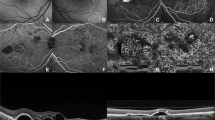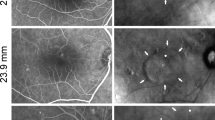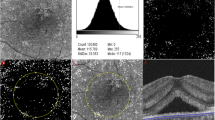Abstract
Purpose
To investigate the anatomic basis of atypical angiographic leaks in central serous chorioretinopathy (CSC) with optical coherence tomography (OCT).
Methods
Fluorescein angiography (FA) and OCT were performed in three eyes of three patients (two men, one woman) with CSC. The angiographic leaks were treated with transpupillary thermotherapy (TTT) in two patients with long-standing CSC. The investigations were repeated in the treated patients during follow-up visits.
Results
Clinically, all patients demonstrated typical CSC; the female patient had subretinal fibrin under the detachment. FA showed unusual leakage patterns and OCT revealed bridging tissue connecting the pigment epithelial detachment (PED) to the overlying detached retina in all patients. CSC resolved completely in the two patients who underwent TTT along with normalization of the OCT findings. In one patient re-evaluated before complete resolution of CSC, OCT showed a flattened PED with disappearance of the bridging tissue and persistent serous detachment. FA demonstrated conversion of the previously atypical leak into a classic ‘smokestack’ configuration. Over the next month, leakage resolved completely. CSC and the anatomical findings persisted in the untreated patient.
Conclusion
OCT identified a potential anatomic basis for unusual angiographic leakage pattern in all three cases of CSC evaluated.
Similar content being viewed by others
Introduction
The most commonly described patterns of fluorescein leakage in central serous chorioretinopathy (CSC) are ‘inkblot’ and ‘smokestack,’ accounting for 93 and 7% of cases, respectively.1 Other rarer forms of angiographic leakage have been referred to as ‘leaking scar,’ ‘blowout,’ and ‘diffuse leakage.’2, 3, 4 In this case series, optical coherence tomography (OCT) findings were identified, which might account for an unusual angiographic leakage pattern observed in three patients over the course of CSC.
Materials and methods
Patients presenting with visual loss due to CSC at a tertiary eye care centre underwent best-corrected visual acuity (BCVA) measurement, dilated fundus examination, and fluorescein angiography (FA). The patients who demonstrated unfamiliar patterns of dye leakage on FA were evaluated with OCT (StratusOCT, Carl Zeiss Meditec, Dublin, CA, USA). Depending on the location of leakage, photodynamic therapy (PDT), transpupillary thermotherapy (TTT), or photocoagulation was considered. The study was approved by the Institutional Review Board; informed consent was obtained from each patient. The primary outcome measure was the correlation of the FA and OCT findings.
Results
Of the 304 outpatients who presented with CSC between June 2004 and May 2005, three were found to have unfamiliar patterns of dye leakage on FA:
Case 1
A 30-year-old man presented with blurred vision OS of 4-month duration. BCVA was 20/20 OD and 20/80 OS. Fundus examination OS showed a CSC with a subtle pigment epithelial detachment (PED) nasal to the fovea (Figure 1a). FA showed pooling of dye within the PED, with poorly defined juxtafoveal leaks inferiorly (Figure 1b). OCT (5 mm line scan) revealed two bands of tissue under apparent traction, bridging the outer surface of CSC and the inner surface of PED (Figure 1c). The bridging tissue appeared to belong to the outer retinal layers, attached to PED at two foci. Intervention was considered appropriate, given the duration of CSC. Photocoagulation was deemed unsafe for the juxtafoveal leakage. PDT was not acceptable to the patient because of financial constraints. In view of the authors' experience with TTT in this condition,5 TTT was also offered, and accepted by the patient. Subthreshold TTT was performed with an 810 nm diode laser (OcuLight SLX, Iridex, CA, USA): 2 mm spot at 160 mW for 1 min.
(a) Fundus photograph of the left macula (case 1) shows a well-defined serous detachment, with a PED nasal to the fovea. The horizontal arrow shows the direction of the OCT scan. (b) FA outlines the serous detachment, with pooling of the dye within PED, and ill-defined leaks near its lower edge. (c) Horizontal 5 mm OCT scan demonstrates serous detachment tagged to PED by a bridging tissue. (d) Post-thermotherapy, FA reveals a smokestack leak; (e) a repeat OCT scan demonstrates resolution of PED and the bridging tissue. (f) Two months later, a horizontal OCT through the centre of fovea demonstrates complete resolution of the CSCR; a minimal RPE elevation is also evident.
One-month post-TTT, BCVA improved to 20/60, with partially regressed CSC and no clinically evident PED. FA revealed the conversion of the anomalous leak into a classic ‘smokestack’ configuration arising from the same focus (Figure 1d). OCT confirmed PED resolution and disappearance of the bridging tissue with excellent preservation of retinal structure (Figure 1e). Two months later, vision had improved to 20/20 and normal macular contours were restored (Figure 1f). Status quo was maintained for 24 months.
Case 2
A 37-year-old woman complained of poor vision OD (20/200). Fundus examination showed a large CSC, with subretinal fibrin and internal-limiting-membrane folds. The left eye had three extrafoveal PEDs with 20/20 vision. FA OD demonstrated two vertically orientated curvilinear bands of fluorescein leakage (Figure 2a). These leaks were observed early in the angiogram and did not arise from focal locations. Multiple PEDs were also observed. A horizontal OCT scan through the lower portion of the right macula revealed multiple bands of tissue connecting the CSC to the PED (Figure 2b). This patient also underwent TTT centred over the lower portion of the vertical leaks (260 mW; 3 mm spot; 1 min). Three months later, the serous detachment had resolved completely, with residual RPE defects in the areas of fibrin accumulation (Figure 2c). OCT confirmed the restoration of retinal contours (Figure 2d). BCVA had improved to 20/60. The findings remained stable for 11 months.
(a) FA of case 2 reveals two vertical curvilinear bands of fluorescein leak; the nasal one looping down and splitting into a fork. These bands did not start as point leaks; but fluoresced in the entire extent en bloc. The arrow indicates the direction of OCT scan. (b) Horizontal OCT (10 mm line scan) through the lower edge of the leaks reveals broad adhesions of thickened retinal under-surface to a large PED. Subretinal fluid shows hyper-reflective echoes indicating fibrin. (c) One month post-thermotherapy, the serous detachment resolved completely; with geographic patches of pigment epithelial atrophy, more prominent in areas where subretinal fibrin accumulated previously. (d) OCT in ‘repeat’ mode confirms resolution of CSC as well as the PED.
Case 3
A 43-year-old man was treated elsewhere with oral steroids (1 mg/kg/day) for presumed ischaemic optic neuropathy OS. He noticed a drop in vision OD after 1 month of steroid treatment, and presented with BCVA of 20/60 OD and 20/200 OS. Fundus examination revealed a CSC OD and disc pallor OS. FA revealed multiple PEDs OD, with an oblique curvilinear band of leakage at the superior edge of the PED superonasal to fovea (Figure 3a). OCT through the superior PEDs demonstrated retinal attachment to the roof of the PEDs (Figure 3b). The steroids were stopped; but findings persisted 2 months later. The patient declined photocoagulation.
Discussion
Iida et al6 described OCT findings in three eyes with CSC where a ‘reflective mass,’ thought to represent subretinal fibrin, bridged the detached retina to the underlying PED. They did not correlate leakage pattern with this finding nor comment on how such a finding might affect leakage morphology.6 In the present case series, subretinal fibrin was clinically evident in only case 2; however, bridging retinal tissue was present in all. We are unaware of any report of such correlation between OCT findings (‘bridging tissue’) and abnormal leakage patterns in CSC.
It is possible that the angiographic leakage patterns reflect the underlying anatomical changes observed by OCT. Such a mechanism is supported by the 1-month post-treatment follow-up observations in case 1 (Figure 1d and e). While the bridging tissue was present, the angiographic leakage pattern was atypical; but post-treatment, when the bridging tissue was no longer present but the detachment remained, the atypical leakage converted to a typical ‘smokestack.’ It is possible that the leakage pattern within the serous detachment could be altered by such bridging tissue due to loculation of the serous cavity, altered fluid current dynamics, physical location in the leakage path, etc. When this physical impediment is removed, the leakage pattern assumes a more typical configuration. The risk factors and mechanisms predisposing to this anatomical change are not known and indeed may vary depending upon ethnicity or other characteristics of a particular patient population. These findings demonstrate the potential usefulness of OCT as an adjunct to FA in suggesting an anatomic basis for anomalous leakage patterns in CSC. Further study is needed to determine whether the clinical outcome or response to treatment is substantially different in this group of patients.
References
Spitznas M, Huke J . Number, shape, and topography of leakage points in acute type I central serous retinopathy. Graefes Arch Clin Exp Ophthalmol 1987; 225: 437–440.
Ciardella AP, Guyer DR, Spitznas M, Yannuzzi LA . Central serous chorioretinopathy. In: Ryan SJ, Schachat AP, Hengst TC (eds). Retina, 3rd edn. Mosby: Philadelphia, 2001, pp 1153–1181.
Gilbert CM, Owens SL, Smith PD, Fine SL . Long-term follow-up of central serous chorioretinopathy. Br J Ophthalmol 1984; 68: 815–820.
Goldstein BG, Pavan PR . Blow-outs' in the retinal pigment epithelium. Br J Ophthalmol 1987; 71: 676–681.
Shukla D, Kolluru C, Vignesh TP, Karthikprakash S, Kim R . Transpupillary thermotherapy for subfoveal leaks in central serous chorioretinopathy. Eye (in press).
Iida T, Hagimura N, Sato T, Kishi S . Evaluation of central serous chorioretinopathy with optical coherence tomography. Am J Ophthalmol 2000; 129: 16–20.
Author information
Authors and Affiliations
Corresponding author
Rights and permissions
About this article
Cite this article
Shukla, D., Aiello, L., Kolluru, C. et al. Relation of optical coherence tomography and unusual angiographic leakage patterns in central serous chorioretinopathy. Eye 22, 592–596 (2008). https://doi.org/10.1038/sj.eye.6702818
Received:
Revised:
Accepted:
Published:
Issue Date:
DOI: https://doi.org/10.1038/sj.eye.6702818
Keywords
This article is cited by
-
Central serous chorioretinopathy: updates in the pathogenesis, diagnosis and therapeutic strategies
Eye and Vision (2023)
-
Smokestack leak in central serous chorioretinopathy
Graefe's Archive for Clinical and Experimental Ophthalmology (2010)






